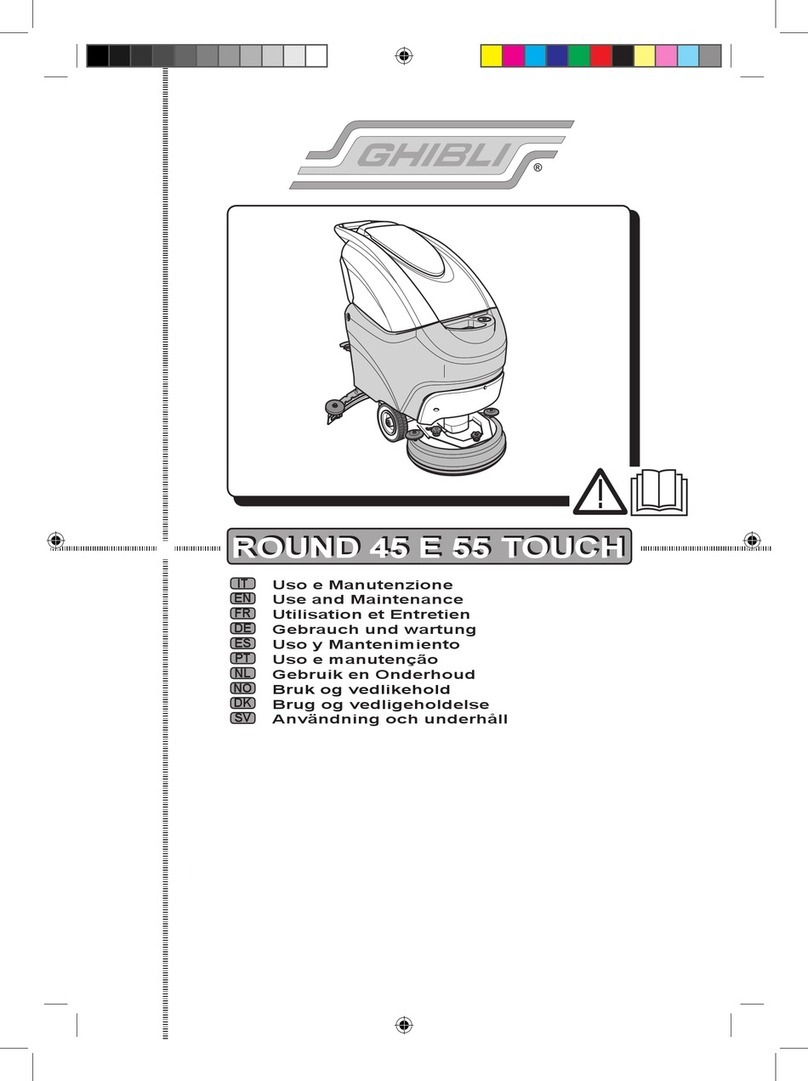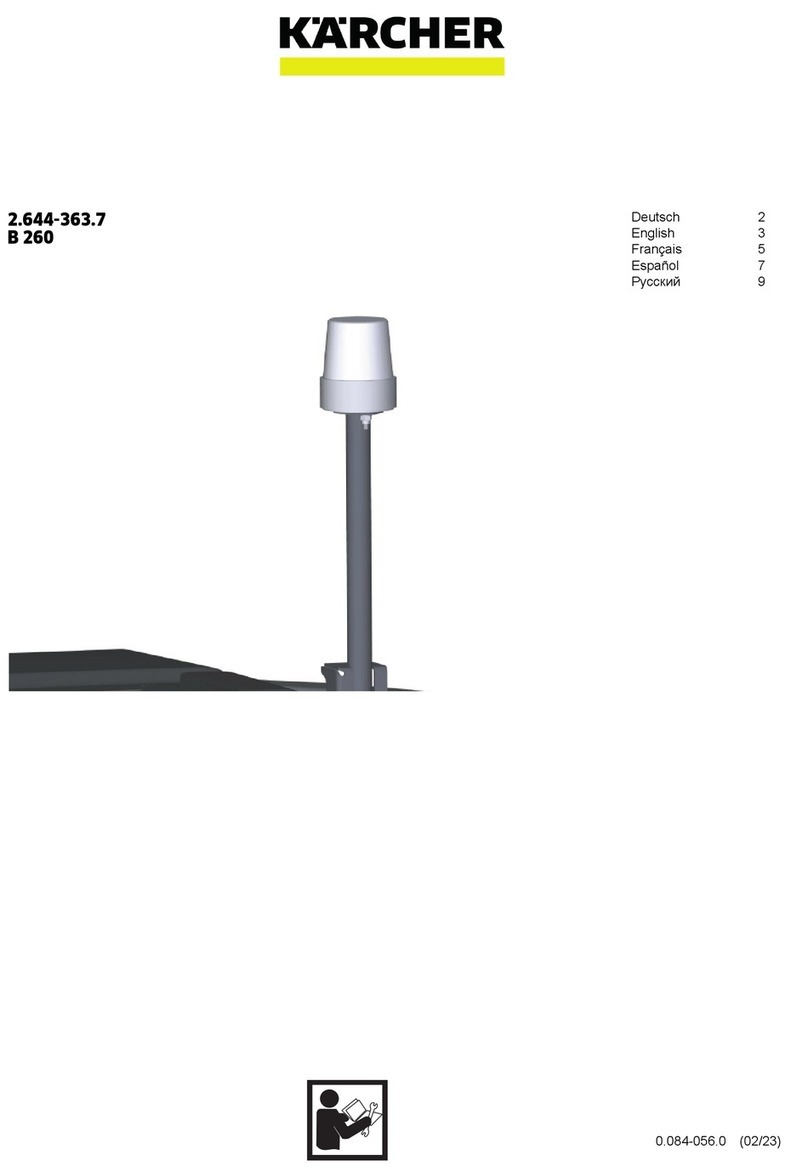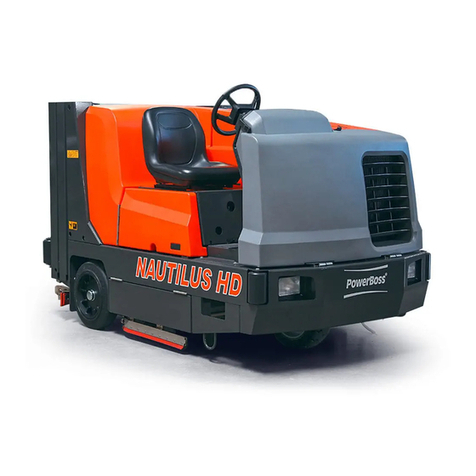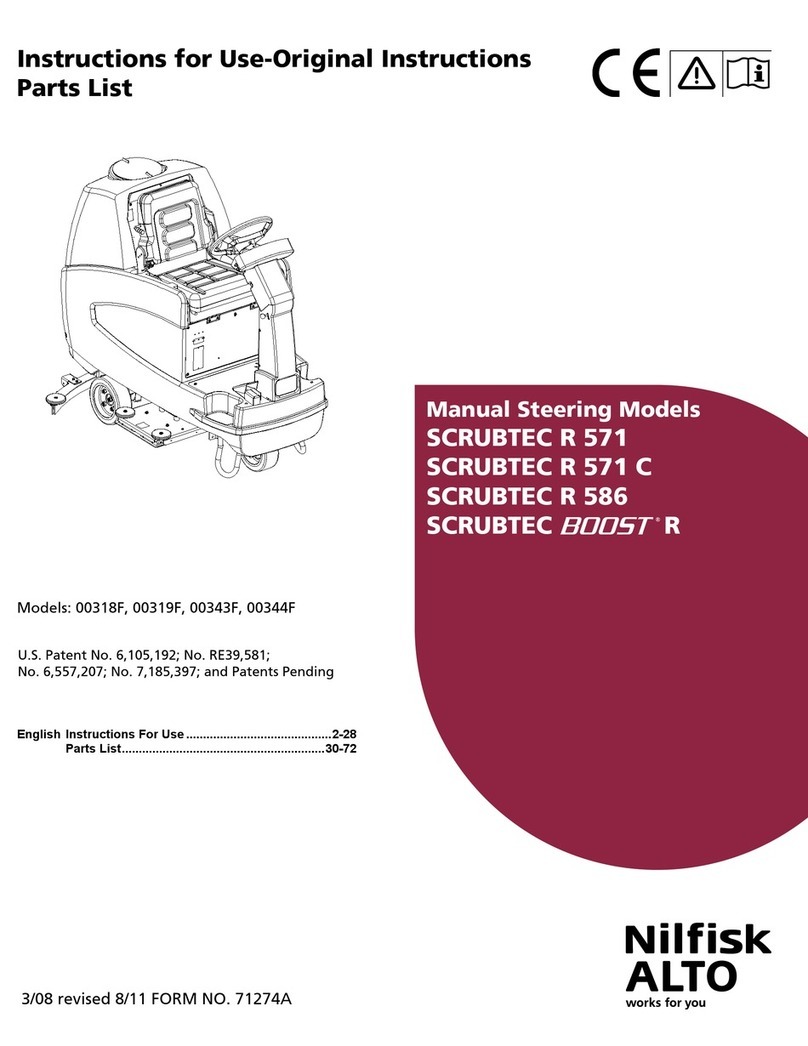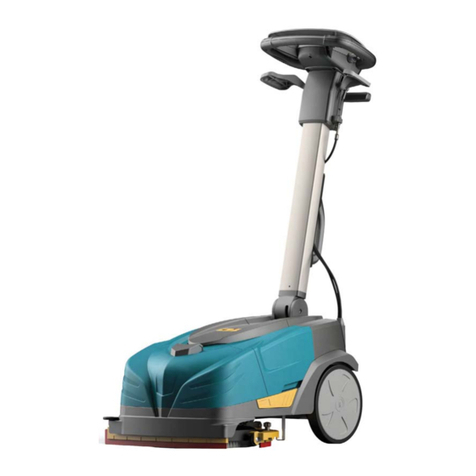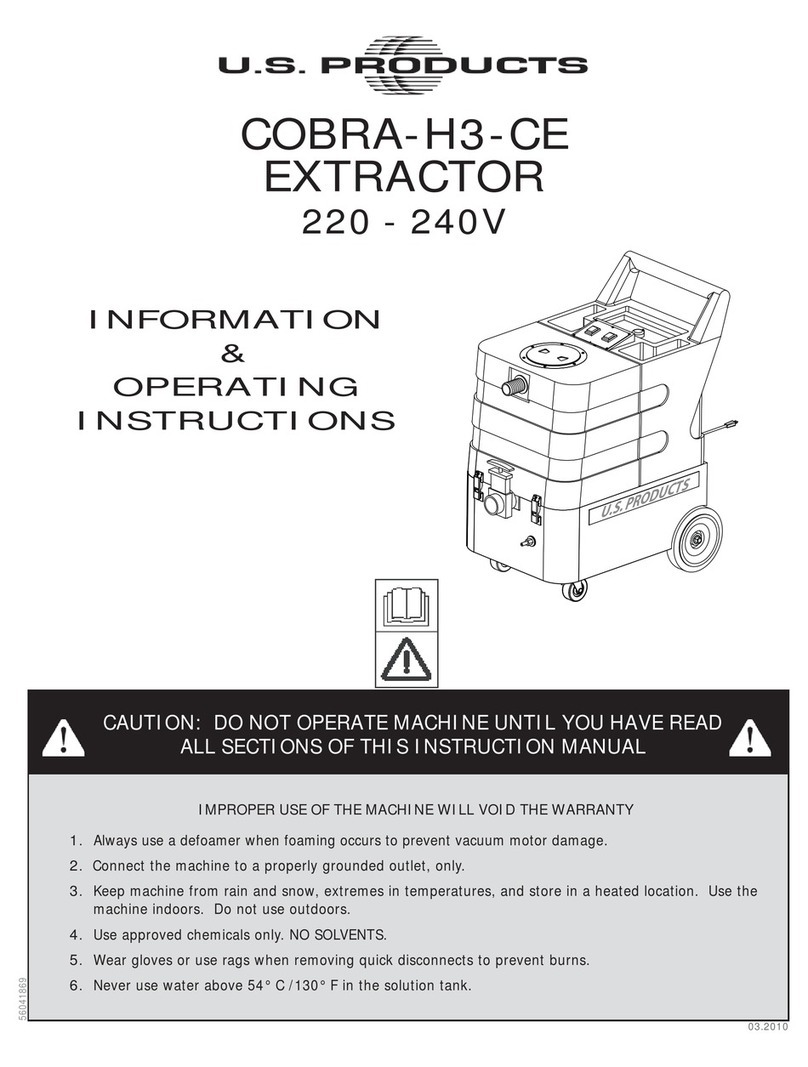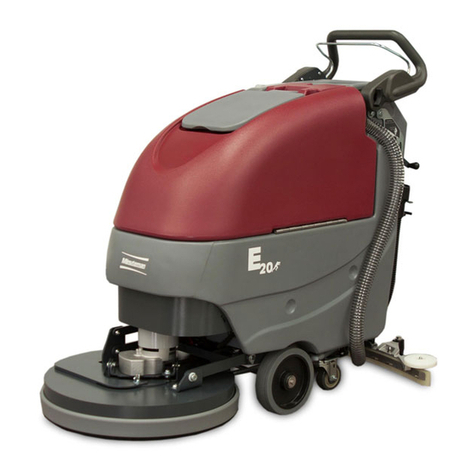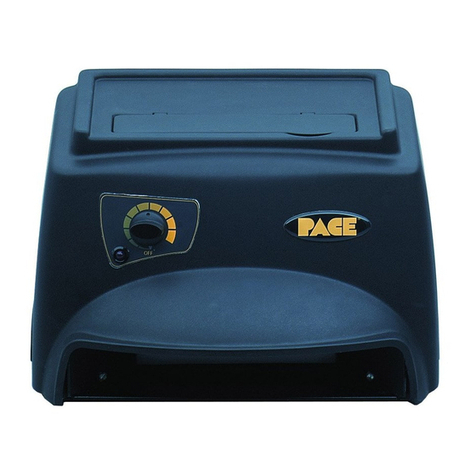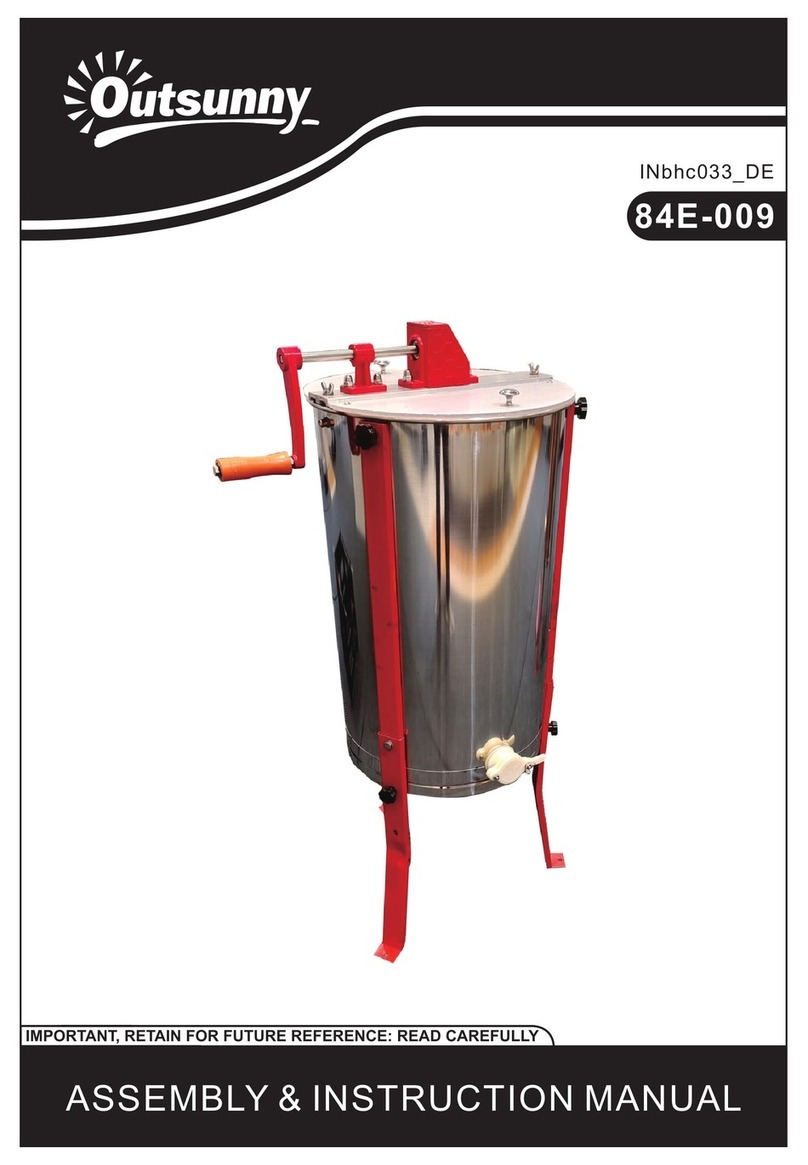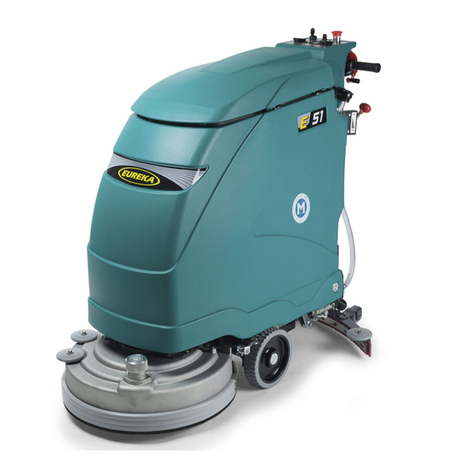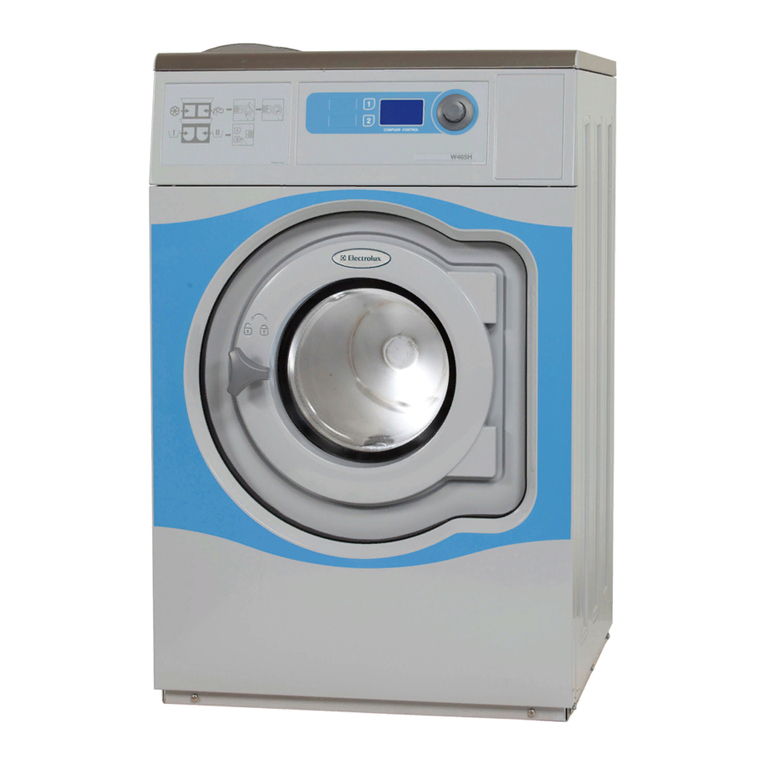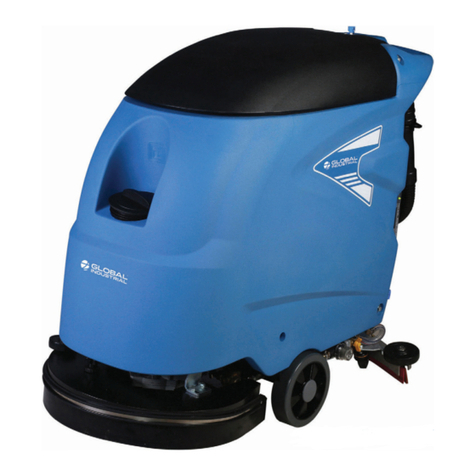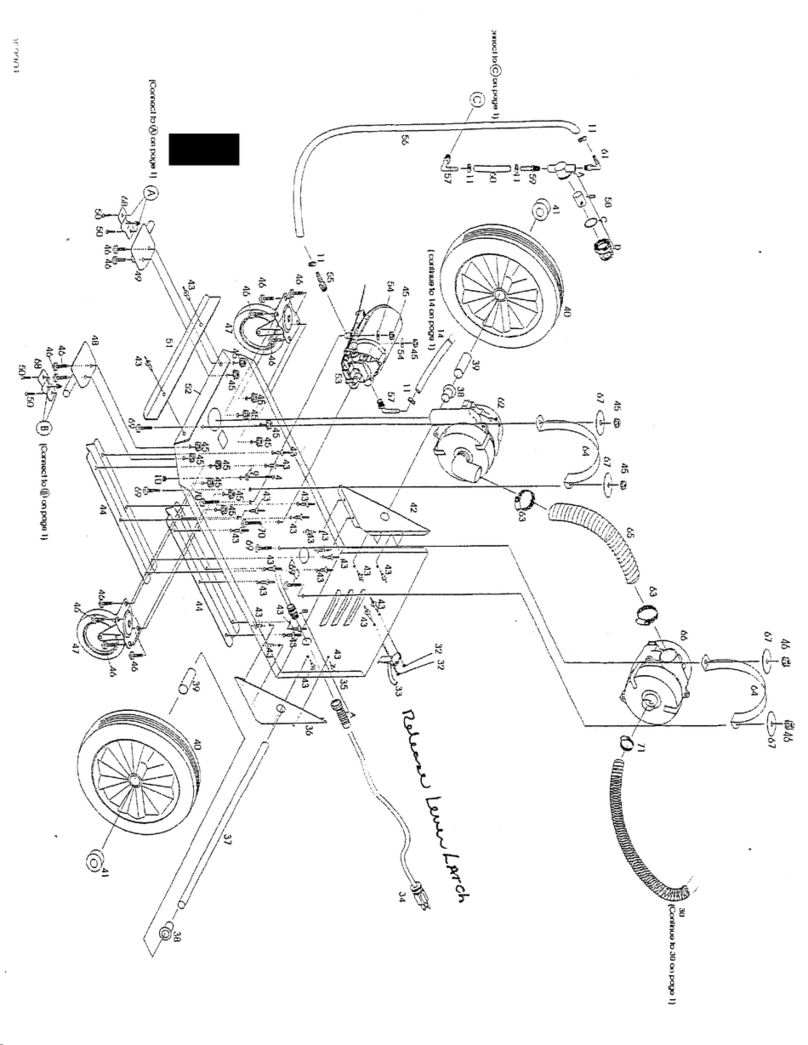RoboVent ProCube HVP-120-575 System manual

Revision E2-20171010 ©2017 ROBOVENT PRODUCT GROUP, INC.
OWNER'S MANUAL & OPERATING INSTRUCTIONS
Original Instructions
Manufactured by: RoboVent Product Group, Inc., 37900 Mound Rd, Sterling Heights, MI 48310, USA | (888) ROBOVENT | www. robovent.com
In Europe: RoboVent Ltd, 25 Momentum Place, Bamber Bridge, Preston PR5 6EF, United Kingdom | +44 1772 626323 | www. robovent-eu.com
OWNER'S MANUAL & OPERATING INSTRUCTIONS
Original Instructions
575 Volt ProCube™ Portable Fume Extractor
Model Number: HVP-120-575
for Serial No. 25760 and higher

575 Volt ProCube Owner's Manual & Operating InstructionsE1-20171020
©2017 ROBOVENT PRODUCT GROUP, INC.
2
Table of Contents
Introduction 3-5
Receiving & Inspection 3
Safety Signs & Symbols 3
Purpose & Limitations 3-4
Prerequisites for Use 5
Specifications 6-9
Specification Chart 6
Data Plate Info 6
Dimensions 7
Airflow Schematic 8
Components 9
Unpacking & Locating 10
Environmental Requirements & Constraints 10
Process for Locating 10
Testing & Commissioning 11
Operating Instructions 12
Preventative Maintenance 13
Wiring Diagrams 14

575 Volt ProCube Owner's Manual & Operating InstructionsE1-20171020
©2017 ROBOVENT PRODUCT GROUP, INC.
3
Introduction
Thank you for choosing the RoboVent ProCube filtration machine. This
high-vacuum unit is designed for industrial environments, collecting
both fumes and dust at the source in welding and related processes. The
energy-eicient motor is directly coupled to the regenerative blower and
operated by onboard controls, combining what might otherwise be a very
complex operation into a simple, user-friendly package. It ships completely
assembled and pre-tested, making it easy to set up and use.
The ProCube machine has been designed for production use and has a few
standout characteristics:
Regenerative blower: The backbone of the machine, it requires little
maintenance, and the advanced design provides the powerful suction
required.
Vertical cartridge filters: Vertical cartridge filters have superior loading
and cleaning performance; RoboVent Endurex filters improve on these
inherent characteristics with proprietary design features that optimize
performance and promote eective pulse cleaning.
Pulsing system: Automatic and eicient, the pulse system ensures filter
life is maximized. Online and oline modes work together as needed to en-
sure filter is consistently cleaned: a quick pulse sheds dust from the filter,
causing it to fall into the hopper area and collect in the disposable contain-
ment tube. Eective pulsing is combined with a filter chamber designed to
prevent re-entrainment of dust, resulting in maximum filter life.
Intuitive controls: Simple, intuitive controls are equipped with auto and
manual blower modes. Optional sensors integrate filtration with welding
processes. Additional electronics monitor airflow and motor speeds to indi-
cate operating condition with green and yellow lights.
With user-friendly electronics and only requiring connections to electricity
and compressed air, the ProCube machine is simple to set up. Additional
details can be found in the section titled “Prerequisites for Use”.
Persons involved with installing, operating, maintaining, and servicing this
RoboVent ProCube machine must read these instructions prior to use. Keep
this manual in a safe and convenient place for reference. In the case of loss
or damage, please contact RoboVent for replacement.
RECEIVING & INSPECTION
The equipment will arrive on a pallet or in a crate. Perform a visual inspec-
tion before removing from the truck. If there is any damage, it should be
noted on the shipping documents and photographed. It is the receiver's
responsibility to file shortage reports and damage claims with the carrier.
The carrier is responsible for any damage to the equipment while it is
in transit. Notify RoboVent if any damage has occurred so repair can be
arranged.
The filter cartridge will be shipped inside the machine.
Before discarding packing material, make sure no small parts are con-
cealed within wrapping.
SAFETY SIGNS AND SYMBOLS
Below are the safety symbols and meanings as used throughout this
manual and on the machine itself. Specific hazards and labels are shown in
the "Specifications" section.
Warning Sign: Yellow Triangle with black edging. Specific icon shown
on the face for specific concerns, or exclamation mark (as shown) for
generic safety alerts to hazardous conditions.
Prohibition Sign: White circle with red edging and crossbar. Specific
icon shown on the face for specific concerns, or STOP (as shown)
for generic alerts to conditions that may lead to damage to the job,
machine or other factor.
Mandatory Sign: Blue circle with white icon. Specific icon shown on
the face for specific concerns, for example as shown, it is mandatory to
consult the manual before operating.
Reference Sign: This symbol indicates that the reader should refer to
the specific section and read about this identified component, task or
location and learn more before continuing. Where this sign is shown,
DO NOT attempt to continue before reading the section as indicated.
PURPOSE & LIMITATIONS
The ProCube filtration machine is designed for use with fume extraction
welding guns in production applications. Its powerful suction, simple
controls, and small footprint are suited for use in many facilities, including
fabrication shops, production facilities, shipbuilding, and large structures.
Optional smooth-rolling wheels and lifting handle enhance mobility for use
in portable applications.
This machine is intended for filtration of airborne fumes and non-explosive
dry dust captured at the source. The design and controls are optimized for
welding processes, especially when used with fume extraction welding
guns, but it can be used intermittently for related processes such as grind-
ing or sanding.

575 Volt ProCube Owner's Manual & Operating InstructionsE1-20171020
©2017 ROBOVENT PRODUCT GROUP, INC.
4
Introduction
Whilst it can perform in ‘high-loading’ applications, such as robotic weld-
ing, plasma cutting, and grinding applications, these processes generate
more fume and particles than what is practical for the collection capacity
of the ProCube machine. Therefore, it is not recommended for use in such
applications.
Some welding conditions or atmospheres can generate oily or sticky
particulate that ‘blinds’ the filter media. Blinding occurs when the pores
in the fiber of the media become blocked so that pulse cleaning does not
remove the blockage, leading to diminished cleaning results, finally result-
ing in reduced filter life. If you notice decreased filter life, or if dierential
pressure of the filter does not drop after an oline cleaning cycle, it may
indicate blinding. You can improve filter condition by welding clean mate-
rial, reducing the amount of oil on parts, and/or limiting use of anti-spatter
spray. Nozzle gel must not be used with fume extraction welding guns.
Metal particulate collected from welding or related processes can be
combustible when built-up in the collector, on the filter, or in hoses.
Combined with the presence of sparks in the incoming air stream, this
presents a potential fire risk. Typically, turbulence in the hose extinguishes
sparks; for additional protection, the machine is equipped with a Delta3
Spark Arrestor. Despite these features, it may be possible for a spark to
get through. Observe the process periodically to ensure intake of sparks
is not excessive. Often, the position of inlets can be adjusted to prevent a
consistent intake of sparks or settings on the process can be adjusted to
reduce sparks.
Follow all regulations applicable to your workplace and usage conditions.
RoboVent or a consultant in your area can assist with compliance
If the intake becomes obstructed, shut the machine down and fix the issue
to prevent overheating of the motor and blower. Overpressure is indicated
by the red band on the airflow gauge.
The blower motor is designed for continuous duty. Starting the motor more
than six times per hour, however, can decrease its life. When using the
AutoSaver function, it is possible for the number of starts to exceed this
count. The program delays shut-o for one minute after welding stops to
evacuate fumes from the hose and to allow for pauses between welds.
Pay attention to a typical production cycle: if there are breaks in welding
longer than one minute, keep track to make sure motor will not be required
to start more than six times per hour. If this frequency will be exceeded,
either switch the unit on before each period of welding, or leave the unit on
throughout the day.
Personal Protective Equipment (PPE) is required when servicing the
machine. Specific requirements are to be determined by applicable
regulations, dust toxicity testing and your workplace policies. As a
general rule, gloves, dust mask and safety goggles are recommended
to prevent exposure to or inhalation of dust.
Some dusts collected from welding and related processes can be
hazardous. The factory is responsible to test for toxicity and determin-
ing precautions for emptying and disposing hazardous waste.
The ProCube is not designed to filter gases, odors or noxious fumes.
This filtration machine is not approved for filtration of Carcinogenic,
Mutagenic, or Reproductively-harmful (CMR) substances.
The ProCube unit is not designed for use in explosive atmospheres,
potentially explosive atmospheres, or for extracting substances from
such atmospheres. Neither is it intended to process substance which
could create an explosive or potentially explosive atmosphere inside
the machine. If the dust to be extracted may create aforementioned
conditions, it must be sampled and tested for explosivity. Responsibility
lies with the factory to perform testing and ensure compliance with
NFPA guidelines.

575 Volt ProCube Owner's Manual & Operating InstructionsE1-20171020
©2017 ROBOVENT PRODUCT GROUP, INC.
5
Introduction
PREREQUISITES FOR USE
All users and maintenance personnel must read this manual before install-
ing, operating, or servicing the RoboVent ProCube. Maintenance personnel
must thoroughly understand the troubleshooting and servicing sections of
this manual.
The machine requires compressed air and electrical connections:
• Compressed air must be regulated to 5.86 bar (85 PSI) and must be
clean and dry according to ISO 8573-1 Class 7. It is recommended to
connect to the machine with a quick-disconnect fitting and flex-
ible hose for portability and easy disconnection when performing
maintenance.
• Electrical supply must be 400 Volts at 50 Hertz. The supply circuit
shall be protected and capable of providing 5.1 Full Load Amps.
• Power cord and air connection are at rear of machine.
The machine will require adjustment of airflow to ensure eective capture;
refer to the operating instructions. It is recommended to check airflow at
the beginning of each shift to ensure fumes are being captured and set-
tings are maintained.
When operating with both inlets, a two-inch ball valve may be required
for balancing airflow. Refer to the "Testing & Commissioning" section.
The machine is limited by the amount of vacuum it can safely create. Too
much resistance by such conditions as unsuitable hose, excessive hose
length or constricted intake can overload the blower and prevent it from
successfully capturing fumes. Changes can be made to setup if machine
does not perform as expected. Review "Testing & Commissioning"
section If you need assistance with adjustment or setup, please contact
RoboVent Customer Service & Tech Support at 888-ROBOVENT.

575 Volt ProCube Owner's Manual & Operating InstructionsE1-20171020
©2017 ROBOVENT PRODUCT GROUP, INC.
6
Specifications
SPECIFICATIONS CHART
Empty Weight 97.7 kg (215 lbs)
Weight Full 104.5 kg (230 lbs)
Filtration Eiciencies MERV16; 99.9% @ 0.3 micron
Equivalent Filter Area 23.8 m2(256 ft2)
Filter Material B16 PTFE Laminated Polyester Media
Maximum Airflow 93 m3/hr @ 25 kPa (55 CFM @ 100 in. w.c.)
Operating Temperature 10 – 50° C (50 – 120° F)
Cabinet Construction 14-gauge Steel, Polyester Powdercoat
Compressed Air Requirements 8.5 m3/hr (5SCFM) @ 5.86 bar (85 psi)
Compressed Air Connection 12.5mm (1/2") NPT with Quick-Connect
Voltage Supply 575 Volts, 60 Hertz, 3.9 Full Load Amps
Control Voltage 24 VDC
Noise Level 68 dB(A)
Floor Pressure 1.2 kg/cm2(17.6 psi)
DATA PLATE INFO
Locate the data plate and record model number, serial num-
ber and manufacture date here for quick reference.
Model No:
Serial No:
Manufacture Date:

575 Volt ProCube Owner's Manual & Operating InstructionsE1-20171020
©2017 ROBOVENT PRODUCT GROUP, INC.
7
Specifications
DIMENSIONS
42.70 [1084.6
]
35.48 [901.3]
22.90 [581.7]
27.00 [685.8]
19.49 [495.1]
17.50 [444.5]
1.00 [25.4]
35.63 [904.9]
3.00 [76.2]
1.50 [38.1]
2.63 [66.7]
2.95 [74.9]
12.30 [312.3]
3.38 [85.7]
5.52 [140.1]
2.50 [63.5] 17.50 [444.5]
8.14 [206.9]
12.31 [312.7]
24.75 [628.7]

575 Volt ProCube Owner's Manual & Operating InstructionsE1-20171020
©2017 ROBOVENT PRODUCT GROUP, INC.
8
Specifications
AIRFLOW SCHEMATIC
Clean Air
Particulate
Contaminated Air
Delta3 Spark Arrestor
stops incoming sparks.
Air is cleaned as it passes through filter.
Particulate builds up on filter.
Blower generates vacuum,
allowing airflow for the machine.
Some particulate drops outs of airstream.
Particulate collects in tube for disposal.
Cleaning air pulse knocks dust o filter.
Muler plenum cuts fan noise.
Clean air exhausts
to workshop.
Contaminated air
from process.

575 Volt ProCube Owner's Manual & Operating InstructionsE1-20171020
©2017 ROBOVENT PRODUCT GROUP, INC.
9
Specifications
COMPONENTS
Delta3
Lifting Handle
Lift Point
Filter Cartridge
Motor & Blower Assembly Feet
Door Controls
Lid / Filter Door
Interlock
Dust Disposal Tube
Pulse Nozzle
Pulse Valve
Pulse Solenoid & Pilot
Tube Sheet
AutoSaver
Connection Point
Muler / Exhaust Plenum
Blower Connection Hose
VFD
Inlet 1
Inlet 2

575 Volt ProCube Owner's Manual & Operating InstructionsE1-20171020
©2017 ROBOVENT PRODUCT GROUP, INC.
10
Unpacking & Locating
Follow workplace safety guidelines when handling and unpacking this
machine. Gloves, safety glasses and safety footwear are recommended.
Set aside a 3 m ( 9 ft) work area to allow adequate space for shipping
material and lifting from pallet. Consider cordoning o to prevent traic
from entering the area.
ENVIRONMENTAL REQUIREMENTS & CONSTRAINTS
This machine is designed to operate in an environment with temperature
10 – 50° C (50 – 120° F) and relative humidity 40-70% (non-condensing).
The ProCube machine is designed for use indoors. Floor surface must be
hard, flat, level, and capable of supporting 1.2 kg/cm2(17.6 psi) in order
for the unit to remain safely stable. Atmosphere must be mostly free from
contaminants such as dust, oil mist, water and airborne chemical solvents.
If outdoor use is required, the machine must be sheltered from wind, blown
dust and precipitation. Storage must be indoors to prevent condensation in
control panel and motor areas.
Explosive Atmospheres
The machine is neither certified nor designed for use in explosive
atmospheres, potentially explosive atmospheres or for collecting explo-
sive dusts. The user is therefore strictly prohibited from using it in such
applications and conditions. Do not attempt to modify this machine for
the purposes of use in any explosive environment.
Lighting
The machine’s work area must be illuminated so that the control panel,
power cord connection and gauges are clearly visible without the need for
additional local lighting.
When servicing, additional temporary lighting may be needed by mainte-
nance personnel.
Vibration
This machine has been assessed and determined, that in normal design
use parameters, this machine oers no appreciable vibration hazards and
as such, does not require any remedial or secondary action to reduce
vibration.
Noise
The machine is designed in such a way as to oer reduced acoustic sound
pressure levels. The machine noise level has been measured and does not
exceed 68 dB(A).
PROCESS FOR LOCATING
Inspect packaging and machine for missing parts or shipping damage as
described in the “Receiving & Inspection” section.
Use the following steps to unpack and locate:
1. Remove packing material and crating from sides.
2. Use a crane attached to lifting points to remove from pallet.
3. Roll the machine to designated area. Connect to process with 50mm.
flexible hose.
4. Adjust airflow to ensure eective fume capture. Refer to operating
instructions.

575 Volt ProCube Owner's Manual & Operating InstructionsE1-20171020
©2017 ROBOVENT PRODUCT GROUP, INC.
11
Testing & Commissioning
Once unit has been connected to power and compressed air, it is important
to verify the machine is operating correctly and adjust airflow to ensure
eective capture.
Record details of setup and settings through pictures and notes. Keep
these on file with a logbook for daily checks.
Verify Machine Operation
Perform these quick checks to verify machine is running correctly:
1. Turn unit on. Listen for blower to ramp up and level o at running
speed. Watch that gauges operate.
2. Flip gun switch. Listen for a change in motor speed.
3. Put your hand over the intake and hold. Unit should display yellow
light and start alarm.
4. Press the pulse button, listen for a rush of air inside the filter cabinet
indicating the pulse valve has opened.
5. Once the function has been confirmed, testing and adjustment can be
performed.
Adjusting Airflow
Speed adjustments will need to be set for both one-gun and two-gun
settings. The intake that is more commonly used should be connected to the
top inlet and intermittent or ‘lesser-use’ intake should be connected to the
bottom inlet, to allow the plug to be used on bottom inlet in one-gun mode.
When using two intakes, additional balancing may be required if there are
any dierences in hose length, fume gun setup or intake design. In these
cases, install a 50mm ball valve (refer to instructions below). To avoid ad-
ditional balancing, it is best to locate the machine centered between work
areas and use identical hoses and intakes / fume guns.
Follow these steps to adjust the speed for one- and two-gun settings:
1. Switch to the two-gun setting and turn the machine on.
2. Compare the airflow at each inlet. The inlet with greater airflow will
need a ball valve installed.
• In the case of fume guns, compare the air flow meters side-by-
side; the gun with more flow will need a ball valve.
• When using a fume gun in conjunction with a hood-type inlet, the
hood will need the ball valve. With flow starting at 100%, adjust
the ball valve on the hood until the fume gun has reached target
flow.
3. Once the intakes are balanced, adjust right speed dial until required
flow is achieved.
4. Now, detach the second intake and plug the lower inlet.
5. Switch to one-gun setting. Measure airflow at the intake and adjust
as needed.
Once settings have been determined, record the position of speed dials
and the resulting air flow or pressure at each intake. Daily readings must
be taken and compared to these values to ensure flow is maintained.
As the filter loads, it may become necessary to increase motor speed to
achieve the airflow originally set. Generally, this adjustment is not required
unless it is 20% dierent from the setup value.
Installing Ball Valve
1. Use a ball valve for 50mm plastic pipe with slip joint connection.
2. Cut two lengths of pipe at 100mm.
3. Glue pipes into valve.
4. Cut hose where ball valve will not cause the hose to pull out of any
connection on cause kinking. Which hose to cut is determined in
"Adjusting Airflow" instructions above.
5. Fit hose over pipe stubs on either side of ball valve and use hose
clamps to seal.
6. Now, adjustment of the ball valve will modify restriction and allow
airflow to be balanced.
Fume Guns
Fume guns are a delicate balance between having enough airflow to cap-
ture the fume and not drawing away shielding gas. Below are a few tips:
• Areas of a weldment that are tight or partially enclosed can allow the
suction to project throughout that volume or along the material and
begin to draw away shielding gas. Changing the nozzle to a design
suited for these applications is recommended if porosity occurs
consistently.
• On right angles, a dierent nozzle is typically not necessary. Often,
adjusting the angle of the nozzle during so intake ports are further
away from the material is enough to correct porosity issues.
• Gas flow should be within recommendation specified by the fume
gun manufacturer. Outside of this range can cause inconsistencies in
the weld or capture.

575 Volt ProCube Owner's Manual & Operating InstructionsE1-20171020
©2017 ROBOVENT PRODUCT GROUP, INC.
12
Operating Instructions
Refer to diagram below for callouts of the control interface located on top
of the filter access. Below are descriptions of the simple control modes.
More than six starts of the motor in one hour can be harmful. Refer to
the “Purpose & Limitations” section for a detailed description.
Manual Mode Operation
Once airflow has been set up according to the “Testing & Commissioning”
section, manual mode is simple to operate – just on when you need it, o
when you don’t. The blower is rated for continuous duty, so it can run for a
complete shift if needed.
AutoSaver Mode Operation
The automatic mode is controlled by optional sensors on the weld unit‘s
power cord. The optional cables connect to the rear of the machine.
Simply turn the mode switch to the far right ‘auto’ position and begin
welding. The sensor will detect an increase in power drawn by the welder
and signal the ProCube unit to start. Adjustment of the sensors’ threshold
screw may be required.
Pulse Cleaning
The ProCube machine is equipped with electronic pulse cleaning. Two
modes are automatically activated, ‘online’ and ‘oline’. Online cleaning
pulses the unit after it has been running for 30 minutes continuously.
Once the unit has been shut o after a 30-minute or longer work period,
an oline pulsing cycle will be initiated. An additional pulsing cycle can be
manual enacted after oline pulsing has run, by pressing the pulse button.
One-Gun / Two-Gun Switch
Hour Meter
Pulse Button
Mode Switch
OFF / ON / AUTO
Filter Dierential Pressure
Filter Dierential Pressure
Yellow Warning Light
Alarm
Green Running Light
Right Speed Dial
2-Gun Setting
Left Speed Dial
1-Gun Setting

575 Volt ProCube Owner's Manual & Operating InstructionsE1-20171020
©2017 ROBOVENT PRODUCT GROUP, INC.
13
Preventative Maintenance
Safety
Changing or emptying the dust containment tube, performing monthly
service or changing filters requires PPE to minimize exposure to metal
dust. It is recommended to wear disposable coveralls, non-porous gloves,
dust mask and safety goggles when performing these procedures. Follow
company MSDS and PPE guidelines.
Dust collected by this machine may be hazardous. Toxicity testing must
be performed by your local waster service provider and dust disposed of
according to local disposal and workplace safety regulations.
Changing the Dust Containment Tube
Change or empty the tube as soon as it is full. The time between changes
will vary with production schedules, processes or other factors. A good
estimate of time required between tube changes can be determined after
a few changes; record percentage full and hours each time to help you
estimate when the next change is needed.
To minimize hazards from dust or hazardous chemicals within the dust, the
tube can be capped and disposed.
To change the dust containment tube, follow these steps:
1. Open filter lid, make sure no piles of dust are built up at the bottom
that will fall out when dust tube is removed. Dust tube level can also
be checked here using a flashlight.
2. Grasp the tube around the middle and press down until top of tube is
visible from the side.
3. Rotate top of tube outward. Once top is clear of machine, downward
pressure can be released and dust either emptied or tube capped and
disposed as deemed appropriate by safety policies.
4. Use a vacuum to pick up any dust that spills.
5. Record machine hours and service action.
Monthly Maintenance
On a monthly schedule, perform the following steps and checks:
1. Start machine, allow it to ramp up. Record machine hours and filter
dierential pressure. Turn machine o once values are recorded.
2. Press the pulse to enact an oline cleaning cycle.
3. Once pulsing has finished, open filter cabinet and brush any piles of
dust into containment tube at bottom.
4. Inspect inside of cabinet and vacuum out large build up of dust.
5. Inspect hoses for leaks and damage.
6. Close filter compartment and start machine again.
7. Record post-cleaning filter dierential pressure.
Filter Change
Once the filter dierential pressure gauge has reached the red zone
(indicated by the green & red) above the gauge it is time to replace the filter.
Perform the procedures outlined in monthly maintenance. While filter com-
partment is open, and once cleaning of dust build-up is complete, replace
the existing filter (Filter Part Number: EX3-11D18-B16)

575 Volt ProCube Owner's Manual & Operating InstructionsE1-20171020
©2017 ROBOVENT PRODUCT GROUP, INC.
14
Wiring Diagrams
RoboVent
37900 Mound Road
Sterling Heights, MI 48310
(586) 698-1800
Q1 Q2 Q3 Q4
12121212
I5 I6 I7 I8I4
I3
I2I1
M
L+
24vdc +
0vdc - 0-10v Analog Input from VFD AM Terminal
Blower Start Input
Auto Start Input 1
Auto Start Input 2
Not Used
1 Gun / 2 Gun input
0-10v Analog Input from Dwyer Pressure Transducer
Pulse Start Input
Pulse Valve Output
24vdc +
Amber Light / Alarm output
24vdc +
Green Light Output
24vdc +
Blower Start / Hour Meter Output
24vdc +

575 Volt ProCube Owner's Manual & Operating InstructionsE1-20171020
©2017 ROBOVENT PRODUCT GROUP, INC.
15
Wiring Diagrams
RoboVent
37900 Mound Road
Sterling Heights, MI 48310
(586) 698-1800
P1P2PCA1 A2 +V AC AM AC MP
S1 SC
Incoming Power Motor Connection
Ground
Run Signal From Terminals
Speed Signal From Terminals / Red Wire in Controls
Speed Signal Voltage Supply to Terminals / Tan Wire in Controls
Speed Monitor 0vdc - to Power Supply -
Speed Monitor Output 0-10v to Input I1
Run Signal
Common - 0vdc-

575 Volt ProCube Owner's Manual & Operating InstructionsE1-20171020
©2017 ROBOVENT PRODUCT GROUP, INC.
16
Wiring Diagrams
RoboVent
37900 Mound Road
Sterling Heights, MI 48310
(586) 698-1800
VFD
24vdc Low Voltage Control Terminal Blocks

575 Volt ProCube Owner's Manual & Operating InstructionsE1-20171020
©2017 ROBOVENT PRODUCT GROUP, INC.
17
Wiring Diagrams
RoboVent
37900 Mound Road
Sterling Heights, MI 48310
(586) 698-1800
OFF / ON / AUTO Switch - Left Side
OFF / ON / AUTO Switch - Right Side
Pulse Button - Left Side
Hour Meter
Red
Red Green
Green
Amber Light
Green Light
1 Gun / 2 Gun Switch - Left Side
1 Gun / 2 Gun Switch - Right Side
Horn
GreenGreen
Red
Single Gun
Potentiometer
Double Gun
Potentiometer

575 Volt ProCube Owner's Manual & Operating InstructionsE1-20171020
©2017 ROBOVENT PRODUCT GROUP, INC.
18
Wiring Diagrams
RoboVent
37900 Mound Road
Sterling Heights, MI 48310
(586) 698-1800
Q1 Q2 Q3 Q4
12121212
I5 I6 I7 I8
I4
I3
I2I1
M
L+
Dwyer
Pressure Transducer IDEC Smart Relay
Eaton 24vdc Power Supply
Yaskawa V1000 Drive
Ground Bar
High Voltage Terminal Blocks
24vdc Low Voltage Control Terminal Blocks Motor
Connections
Power Supply
Connections

575 Volt ProCube Owner's Manual & Operating InstructionsE1-20171020
©2017 ROBOVENT PRODUCT GROUP, INC.
19
Wiring Diagrams
RoboVent
37900 Mound Road
Sterling Heights, MI 48310
(586) 698-1800
Control Cable
Wire Color Function Origin Destination
Brown 24vdc Power Power Supply NA
Gray 0vdc Power Supply NA
Blue Manual Run OFF/ON/Auto Switch Terminals/I2 Input
Pink Auto Run OFF/ON/Auto Switch Terminals/Auto Start
Receptacles
Black Pulse Start Signal Pulse Button Terminals / I8 Input
Purple Hour Meter Hour Meter Terminal / Q1 Output
Yellow Low Flow Alarm Amber Light / Horn Terminal / Q3 Output
Green Safe Flow Green Light Terminal / Q2 Output
Red Motor Speed Control 1 Gun/2Gun
Potentiometers
Terminal / A1 VFD
Control Terminal
Tan Motor Speed Control 1 Gun / 2 Gun Switch Terminal / +V VFD
Control Terminal
Orange Low Airflow Alarm
Selection
1 Gun / 2 Gun Switch Terminal / I6 Input
White Low Airflow Alarm
Selection
1 Gun / 2 Gun Switch Terminal / Power
Supply +
RoboVent BOM
Part Number Reference
Number Location Description Qty
FNQ-R-10 Primary Fusing 3
EHCC3DU Fuse Holder 1
DPT-616KD-B-01-V Pressure Transducer 1
HVP-PC-24 HVP 24V Smart Relay 1
ELEC-300 Safety Switch 1
ED-3-480 3HP 480 Volt eDrive w/Auto 1
ELEC-297 Amber Pilot Light 1
ELEC- 298 Green Pilot Light 1
ELEC-296 Alarm Buzzer 1
ELEC-295 Selector Switch Two Position 1
ELEC-308 Switch Contact Block 3
ELEC-274 Selector Switch Three Position 1
ELEC-275 Push Button 2
ELEC-001 Screw Terminal Blocks 36
ELEC-031 Ground Bar 1
Table of contents
Other RoboVent Scrubber manuals



